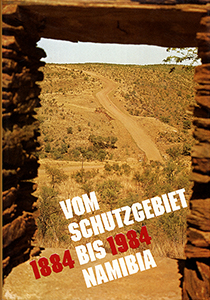Chronology of Namibian History (Second Edition), by Klaus Dierks

Chronology of Namibian History (Second Edition), by Klaus Dierks. Namibia Scientific Society. 2nd edition, Windhoek. Namibia, 2002. Namibia: ISBN 99916-40-10-X / ISBN 978-99916-40-10-5 Germany: ISBN 3-933117-72-0 / ISBN 978-3-933117-72-4
Late Dr. Klaus Dierks (1936-2005), who was a german engineer by profession as well as a historian, had applied an "engineering approach" to Chronology of Namibian History (Second Edition), in order to advance its accuracy.
Chronologies tend to be tiresome to read, but they are informative and useful, particularly if they incorporate a comprehensive index, as this one does. This chronology can be used as a reference source in researching, for instance, what events took place in a specific year, the delimitation over time of Namibia's boundaries, the full spectrum of United Nations resolutions adopted on Namibia, or the leadership and dates of birth and dissolution of political parties and other interest groups. It must be noted, however, that the chronologies of Namibian history produced to date, including this one, are inevitably problematic in that, because the country's archaeology is still in its infancy, a comprehensive account of its pre-colonial history cannot be produced with any certainty. For this reason also, historical evidence on the whereabouts, lifestyle and development of many Namibian communities is scarce, if not totally lacking. This chronology has been divided up as follows. The first section chronicles the pre-historical period from the southern African Middle Stone Age to approximately 1200 AD, at which time the first archaeological evidence of human-made pathways in Namibia came into being. The next section takes us into the period of the explorers, hunters and traders who resided in Namibia between 1486 and 1800. This period is followed by the pre-colonial period of the missionaries, and the section on the missionary period is divided into two sub-sections: the period of missionaries arriving to work in Namibia, and that of the missionaries interfering in Namibian politics. We then enter the formal colonial period, which began with the advent of German rule in 1884. This formal colonial period is divided into four sub-periods: the initial period of occupation from 1884 to 1889, the period from 1890 to 1903 which saw the Initiation of active resistance against the German administration (nineteen uprisings by various Namibian communities against the Germans during this period, all in all there have been 30 uprisings against the German/ South African colonial authorities between 1890 and 1959), the period from 1904 to 1906 when the resistance culminated in central and southern Namibia, and finally the period from 1906 to World War I when the Germans consolidated their power. The next section chronicles the period of South African rule in Namibia, and this period is divided into five sub-periods: the period of South African military rule from 1915 to 1918, the period from 1918 to 1945 when Namibia became a Mandate of the League of Nations, the period from 1946 to 1956 when the United Nations endeavoured to make Namibia a UN Trusteeship Area, the period from 1956 to 1974 when the struggle against South Africa commenced, and finally the period from 1975 to 1987 which saw a succession of South African interim administrations and the Start of the attenuated process leading to independence. The final section covers the period immediately preceding independence in 1990, and the subsequent reintegration of Walvis Bay and the Atlantic off-shore islands into the new Republic of Namibia in 1994. The historical researcher is presented with several unique problems in relation to the earlier periods of Namibian history. Apart from the fact that information sources on these periods are fragmentary, contradictory, or just non-existent, the Gothic-like handwriting of German missionaries and officials makes the available sources exceptionally difficult to work with. [...]
This is an excerpt from Chronology of Namibian History (Second Edition), by Klaus Dierks.
Title: Chronology of Namibian History
Subtitle: From Pre-historical Times to Independent Namibia
Author: Klaus Dierks
Publisher: Namibia Scientific Society
2nd edition, Windhoek. Namibia, 2002
Namibia: ISBN 99916-40-10-X / ISBN 978-99916-40-10-5
Germany: ISBN 3-933117-72-0 / ISBN 978-3-933117-72-4
Original softcover, 15 x 21 cm, 484 Seiten, some bw-photos
Dierks, Klaus im Namibiana-Buchangebot
Chronology of Namibian History. From Pre-historical Times to Independent Namibia
This is the first edition of: Chronology of Namibian History. From Pre-historical Times to Independent Namibia, datin from 1999.
Vom Schutzgebiet bis Namibia 1884-1984
'Vom Schutzgebiet bis Namibia 1884-1984' ist mit 85 Beiträgen ein hochinteressanter und vielfältiger Kultur- und Gesellschaftsspiegel aus den letzten Jahren vor der Unabhängigkeit Namibias.
IIKhauxa!nas
IIKhauxa!nas is a account on the discovery of the ruins of a fortified place constructed by Orlam Afrikaners.
Chronology of Namibian History
Chronology of Namibian History: From Pre-historical Times to Independent Namibia (Second Edtion).
Chronologie der namibischen Geschichte
Die Chronologie der namibischen Geschichte umfaßt die Spanne von der vorgeschichtlichen Zeit bis zur Unabhängigkeit Namibias.





